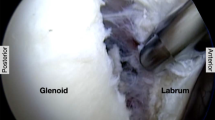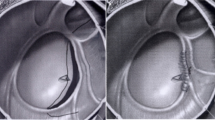Abstract
Purpose
Presumably, the technique of SLAP refixation has significant influence on outcome. This study analyzes and compares functional outcome and return to sports after arthroscopic suture anchor (SA) and arthroscopic transglenoidal suture (TS) repair of isolated SLAP-2 lesions.
Methods
Twenty-four competitive amateur athletes constituted the two treatment groups of this retrospective matched-pair analysis. In the SA group (n = 12), the mean age was 39.1 years (±12.0) and the mean follow-up period was 4.0 years (±0.6). In the TS group (n = 12), the mean age was 33.8 years (±12.0) and the mean follow-up period was 3.7 years (±0.9). The minimum follow-up period was 2.0 years. Primary outcome measures were the absolute constant-score (CS), the subjective shoulder value (SSV) as well as the ability to return to sports.
Results
The mean CS in the SA group was 91.6 (±5.5) compared to 81.3 (±15.5) in the TS group (p = 0.04). The mean SSV after SA repair was 96.9 (±4.6) compared to 80.0 (±20.8) after TS repair (p = 0.01). Both scores showed significantly higher standard deviations within the TS group (p < 0.05). Twelve of eighteen patients (67 %) were able to return to their overhead sports without restrictions (5/9 in the SA group and 7/9 in the TS group; p > 0.05). Fourteen of twenty-four patients (58 %) achieved their preinjury sports levels (8/12 in the SA group and 6/12 in the TS group; p > 0.05).
Conclusions
Superior objective and subjective shoulder function was obtained following arthroscopic SA repair compared to arthroscopic TS repair of isolated SLAP-2 lesions. In addition, results of SA repair were more predictable. However, nearly half of the athletes did not achieve full return to sports regardless of the applied technique of refixation.






Similar content being viewed by others
References
Cordasco FA, Steinmann S, Flatow EL et al (1993) Arthroscopic treatment of glenoid labral tears. Am J Sports Med 21(3):425–430 (discussion 430–421)
Wilk KE, Reinold MM, Dugas JR et al (2005) Current concepts in the recognition and treatment of superior labral (SLAP) lesions. J Orthop Sports Phys Ther 35(5):273–291
Nam EK, Snyder SJ (2003) The diagnosis and treatment of superior labrum, anterior and posterior (SLAP) lesions. Am J Sports Med 31(5):798–810
Kumar VP, Satku K (1990) Tenodesis of the long head of the biceps brachii for chronic bicipital tendinitis. Long-term results. J Bone Joint Surg Am 72(5):789–790
Boileau P, Parratte S, Chuinard C et al (2009) Arthroscopic treatment of isolated type II SLAP lesions: biceps tenodesis as an alternative to reinsertion. Am J Sports Med 37(5):929–936
Field LD, Savoie FH 3rd (1993) Arthroscopic suture repair of superior labral detachment lesions of the shoulder. Am J Sports Med 21(6):783–790 (discussion 790)
Caspari RB, Beach WR (1993) Arthroscopic anterior shoulder capsulorrhaphy. Sports Med Arthrosc 1(4):237–241 pii: 00132585-199300140-00001
Morgan CD, Burkhart SS, Palmeri M et al (1998) Type II SLAP lesions: three subtypes and their relationships to superior instability and rotator cuff tears. Arthroscopy 14(6):553–565
Kim SH, Ha KI, Choi HJ (2002) Results of arthroscopic treatment of superior labral lesions. J Bone Joint Surg Am 84-A(6):981–985
Brockmeier SF, Voos JE, Williams RJ 3rd et al (2009) Outcomes after arthroscopic repair of type-II SLAP lesions. J Bone Joint Surg Am 91(7):1595–1603
Oh JH, Lee HK, Kim JY et al (2009) Clinical and radiologic outcomes of arthroscopic glenoid labrum repair with the BioKnotless suture anchor. Am J Sports Med 37(12):2340–2348. doi:10.1177/0363546509346543
Galano GJ, Ahmad CS, Bigliani L et al (2010) Percutaneous SLAP lesion repair technique is an effective alternative to portal of Wilmington. Orthopedics 33(11):803. doi:10.3928/01477447-20100924-15
Tuite MJ, Cirillo RL, De Smet AA et al (2000) Superior labrum anterior–posterior (SLAP) tears: evaluation of three MR signs on T2-weighted images. Radiology 215(3):841–845
Snyder SJ, Banas MP, Karzel RP (1995) An analysis of 140 injuries to the superior glenoid labrum. J Shoulder Elbow Surg 4(4):243–248
Burkhart SS, Morgan CD, Kibler WB (2003) The disabled throwing shoulder: spectrum of pathology. Part II: evaluation and treatment of SLAP lesions in throwers. Arthroscopy 19(5):531–539
O’Brien SJ, Allen AA, Coleman SH et al (2002) The trans-rotator cuff approach to SLAP lesions: technical aspects for repair and a clinical follow-up of 31 patients at a minimum of 2 years. Arthroscopy 18(4):372–377
Pagnani MJ, Speer KP, Altchek DW et al (1995) Arthroscopic fixation of superior labral lesions using a biodegradable implant: a preliminary report. Arthroscopy 11(2):194–198
Samani JE, Marston SB, Buss DD (2001) Arthroscopic stabilization of type II SLAP lesions using an absorbable tack. Arthroscopy 17(1):19–24
Yoneda M, Hayashida K, Izawa K et al (1996) A simple and secure anchoring system for Caspari’s transglenoid multiple suture technique using a biodegradable poly-l-lactic acid button. Arthroscopy 12(3):293–299
Resch H, Kathrein A, Golser K et al (1992) Arthroscopic and percutaneous bone screw techniques with a new screw system. Unfallchirurg 95(2):91–98
Sassmannshausen G, Sukay M, Mair SD (2006) Broken or dislodged poly-l-lactic acid bioabsorbable tacks in patients after SLAP lesion surgery. Arthroscopy 22(6):615–619
Lorbach O, Wilmes P, Brogard P et al (2008) Complications related to implants in arthroscopic shoulder surgery. Orthopade 37(11):1073–1079
Mileski RA, Snyder SJ (1998) Superior labral lesions in the shoulder: pathoanatomy and surgical management. J Am Acad Orthop Surg 6(2):121–131
Kanatli U, Ozturk BY, Bolukbasi S (2011) Arthroscopic repair of type II superior labrum anterior posterior (SLAP) lesions in patients over the age of 45 years: a prospective study. Arch Orthop Trauma Surg 131(8):1107–1113. doi:10.1007/s00402-011-1348-8
Ide J, Maeda S, Takagi K (2005) Sports activity after arthroscopic superior labral repair using suture anchors in overhead-throwing athletes. Am J Sports Med 33(4):507–514
Rodosky MW, Harner CD, Fu FH (1994) The role of the long head of the biceps muscle and superior glenoid labrum in anterior stability of the shoulder. Am J Sports Med 22(1):121–130
Morgan RJ, Kuremsky MA, Peindl RD et al (2008) A biomechanical comparison of two suture anchor configurations for the repair of type II SLAP lesions subjected to a peel-back mechanism of failure. Arthroscopy 24(4):383–388
Domb BG, Ehteshami JR, Shindle MK et al (2007) Biomechanical comparison of 3 suture anchor configurations for repair of type II SLAP lesions. Arthroscopy 23(2):135–140
Dines JS, Elattrache NS (2008) Horizontal mattress with a knotless anchor to better recreate the normal superior labrum anatomy. Arthroscopy 24(12):1422–1425
Conflict of interest
None of the authors has personal or financial conflicts of interest to disclose.
Author information
Authors and Affiliations
Corresponding author
Rights and permissions
About this article
Cite this article
Maier, D., Jaeger, M., Ogon, P. et al. Suture anchors or transglenoidal sutures for arthroscopic repair of isolated SLAP-2 lesions? A matched-pair comparison of functional outcome and return to sports. Arch Orthop Trauma Surg 133, 227–235 (2013). https://doi.org/10.1007/s00402-012-1657-6
Received:
Published:
Issue Date:
DOI: https://doi.org/10.1007/s00402-012-1657-6




